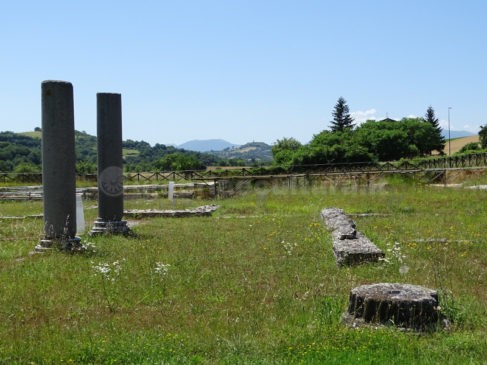The archaeological park of Sentinum, near Sassoferrato in the province of Macerata, houses the ruins of the ancient Roman city of the same name.
The battle of 295 that took place in Sentinum, the Third Samnite War, saw the prevalence of Rome over Gauls, Samnites and Etruscans, alongside the Picenes. From this moment on, Rome is a power that expands nationally. In the period following this battle, I-II-III century a. C., Rome founds a series of cities, which are nothing more than the settlement of veterans (those who made a career in the army), to whom lands were entrusted, as per typical Roman modus operandi: they built roads to enter the territories and then install their veterans there.
The territory of Sentinum was also affected by the bellum perusinum, the clash between Marco Antonio and Ottaviano, in the middle of the first century BC. The former veterans of Marco Antonio lived in Sentinum so, at the outbreak of the war, Octavian’s troops razed the city of the devotees to his opponent. Some traces of fire can still be found in the deeper layers of the excavation.
What can be appreciated now, in the archaeological park, are the reconstructions of subsequent eras. Sentinum enjoyed centuries of economic well-being, from Octavian onwards, at least until the third century AD, to then begin the descending parable until it was abandoned in the fourth – fifth century AD. being helpless, thus positioned on a plain, when the barbarian hordes arrived. From that moment on, left totally unattended, Sentinum was used as a quarry of material that was reused, for example, also in the construction of Santa Croce di Sassoferrato, unfortunately making it impossible to read from an archaeological point of view.
Sentinum rose between the Sentino and Marena rivers whose waters it benefited. In the center of the city there was a 380 sq m spa complex of which a natatio (swimming pool) can be identified, the inorganic architecture of the complex denounces an enlargement in various phases of the building which was initially built smaller, the hot areas of the spas can be identified thanks to the suspensions, the columns in brick material which, by raising the flooring, allowed the passage of the hot air produced by the boilers.
The walled city covers an area of about 15 hectares, the basoli of a minor route, although almost 4 meters wide, are visible; the Foro should be contained between this minor and the maximum route.
The discovery of a building used as a foundry was important: many working slags were found under the counter, one of which has the same alloy as the bronzes of Cartoceto di Pergola which, perhaps, were melted right here.
Two prominent mosaics were found in the 1800s: one depicting the god Aion, the god of infinite time placed within the zodiac, with the goddess Earth and the four seasons represented by four cherubs. This vast mosaic, which is probably the floor of the representation hall of a domus, is exhibited in a museum in Munich. The second mosaic, ruined by neglect, represented the ocean god.
The Sassoferrato museum houses three mosaic floors belonging to Sentinum of uncertain origin, one depicting the Rape of Europe, one with geometric decoration and one with sea monsters.
Outside the southern gate of the city, from where the thistle came out, a 7,000 square meter thermal building was found right behind the road, perhaps built outside the walls due to space problems. This was a multifunctional building with spa, hotel, gym of 35 x 65 meters porticoed with herringbone brick flooring. The discovery of at least 15 different marbles, from various parts of the world, testify the richness of the building.
Benedetta Tintillini
Find Sentinum Archaeological Park on Google Maps:



